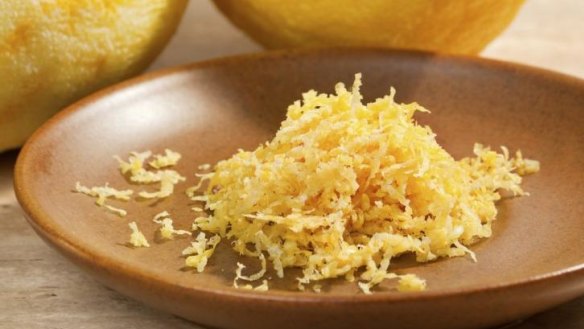Growing citrus in Canberra for winter harvest

May can be a very interesting month for gardeners, as the summer crops are all finished and the cold winds of winter begin to swirl. Questions abound, especially if you have moved into a new home or are doing a makeover. The same question comes from chefs who are keen to have a kitchen garden close to their restaurant.
What can be planted for a winter harvest? What options are there for plants that can grow and be harvested in the cold winter months?
We have been harvesting our late autumn crops of grapefruit and mandarins and have been cooking with sprigs of herbs from those evergreen, aromatic plants. Let us take the subject of citrus and explore the options.
Our grapefruit have been ripening and they are enormous this year. This is the result of very few fruit hanging on the tree and abundant rain in March and April, when the fruit was ripening. As well, we have had the best mandarin crop ever. Our trees are planted next to twin rows of American brambleberries so in the hot summer months regular watering was assured. Then the autumn rains and extended warm weather produced an abundant citrus crop.
Citrus trees are more suited to the temperate climates but you can grow them in Canberra if you take some precautions. Citrus trees dislike the cold westerly winds of late winter. In fact, as they begin to send out new shoots and buds, any icy cold winds will burn off those tips and cause long term damage.
Select a sheltered, sunny location for all citrus trees. If you are designing a new home, then take into account the fact that a north-facing brick wall can provide reflective warmth to many plants, including citrus. When designing a new garden section, position new citrus trees to the east of some windbreak trees, such as photinias, hakeas or olive trees that are all very bushy.
Alternatively you can erect a barrier of slatted wood or use a double layer of shade cloth or hessian to provide protection.
The older leaves of citrus are quite hardy and they can endure winter quite well. It is all about the new growth. To help ensure you protect the new growth to the maximum, do not do any pruning of your citrus until October, even if a tree looks somewhat straggly. The old leaves and branches provide important protection.
Another good option for citrus is to grow them in large terracotta pots. Because the trees can grow to up to two metres in height, select quite a large pot and agree on a permanent location before filling up the pot. Fill the bottom of the pot with small rubble stones to provide good drainage, then add in a good mix of pliable soil and compost. If possible, add a small bag full of sandy loam to assist with the drainage. Remember to keep them well watered during the summer, as pots cannot provide moisture retention as well as a well prepared, deep garden bed.
Like many other trees, the root systems of citrus are quite shallow. This means you need to keep the surface soil well weeded and mulched to minimise competition for nutrients. Take care when digging around the tree to avoid cutting any roots.
Citrus also should be fed in autumn and spring. To produce a bountiful harvest, citrus need a rich soil as they are '‘gross'' feeders. I consider a generous helping of old chicken manure around the drip line of the tree is one of the best natural fertilisers.
With lemons, if you are able to provide good protection, then the Eureka or Lisbon lemon will provide quality fruit. If you only have an exposed location, then the hardier Meyer lemon is a safer bet. Meyer lemons are ready to pick in late autumn and after they are picked, can be kept in a cool, dry storage box for several months.
Emperor mandarins are perhaps the sweetest in taste, with excellent flavour and are large. All mandarins tend to be biennial, so if you see a big number of little mandarins set on the tree then take an hour one morning in summer to thin off a good proportion of the fruit.
Ripe grapefruit, soaked overnight in honey, is one of the breakfast delights of home gardeners. You need to be patient with their growing season. We have a crop of cricket-ball-sized, dark green fruit now hanging on our tree and they will not be ripe until the middle of spring. It is a unique feature to see the ripe old grapefruit still hanging on the tree while the next crop of little fruits are developing. Whenny is a very good, cold-tolerant grapefruit. It is very juicy and has a lemony flavour. Marsh Seedless has a creamy-white flesh and pale yellow skin and is widely grown where it can be protected from the coldest days. And you may try to grow a Ruby or Thompson pink-fleshed grapefruit in a pot outside your kitchen door.
Limes and tangelos are two other citrus trees that you can grow, especially in larger pots. Tangelos are a cross between a grapefruit and a mandarin. They have the tang of the grapefruit and the thin, easy to peel skin of the mandarin.
Owen Pidgeon runs the Loriendale Organic Orchard near Hall.

Tarte au Citron
castor
To prepare the pastry, sift the flour and salt onto a kitchen work surface and make a well in its centre. Chop the butter and work it gently with your fingers until soft. Add the sugar to the butter and mix well, then add in the eggs and mix. Take the butter mixture and rub into the flour, by gently rubbing between your thumb and index finger. Knead several times to produce a smooth dough. Roll into a ball, wrap in clingwrap and put into the refrigerator for at least one hour
Preheat the oven to 190C. Roll out the pastry to line a 23cm round fluted tart dish. Place the pastry in the tart pan and chill in the refrigerator for 20 minutes.
Cover the pastry shell with greaseproof paper and fill with rice. Blind bake the pastry for 10 minutes, remove the rice and paper and then bake for a further three to five minutes, until the pastry is just cooked but still very pale. Remove from the oven and allow to cool.
Whisk the eggs, additional egg yolks and sugar together. Add the cream while whisking continuously. Then add in the lemon juice and zest.
Reduce the oven temperature to 150C. Carefully pour the filling into the pastry case. Return to the oven and cook for 35 - 40 minutes until the filling has set. Leave to cool completely before serving.
Recipe from The Food of France, Murdoch Books
This week in the garden
- Rake up autumn leaves as they fall and add to your compost heap, along with the fast-growing grasses and weeds. Add water whenever you find your compost to be dry - keep the heap moist. Heat is needed to help with decomposition.
- Sow onion seeds into propagation trays for winter planting. If you have not had the chance to plant our winter peas and broad beans, there is still time this week.
- Keep the weeds at bay from your earlier plantings of garlic.
- Aim to complete pruning all your peach, nectarine and plum trees before the end of May, Remember to remove and dispose of any mummified fruit to minimise disease carry-over.
- Begin preparing holes for any fruit trees that you intend to plant during the winter.
Restaurant reviews, news and the hottest openings served to your inbox.
Sign up